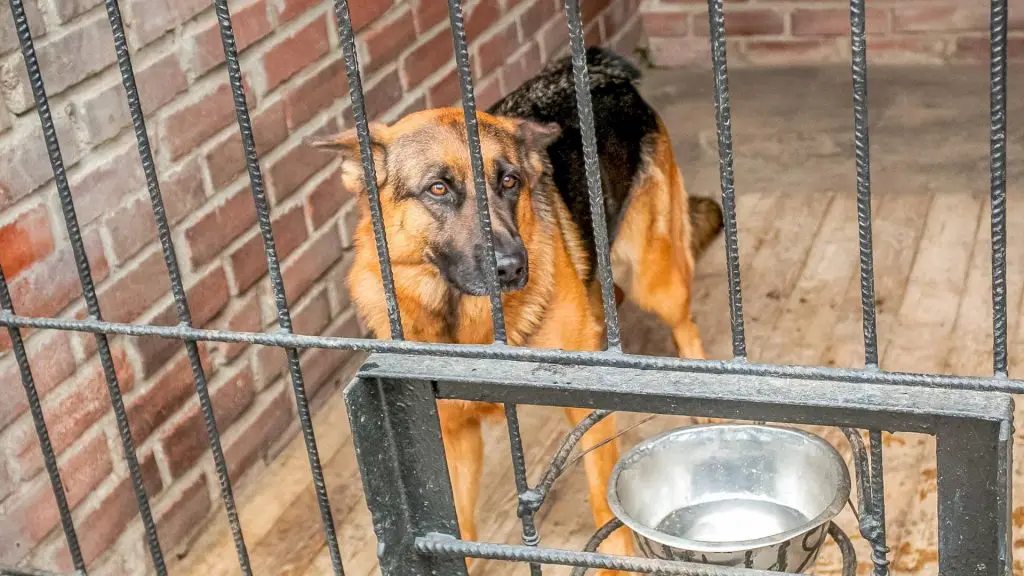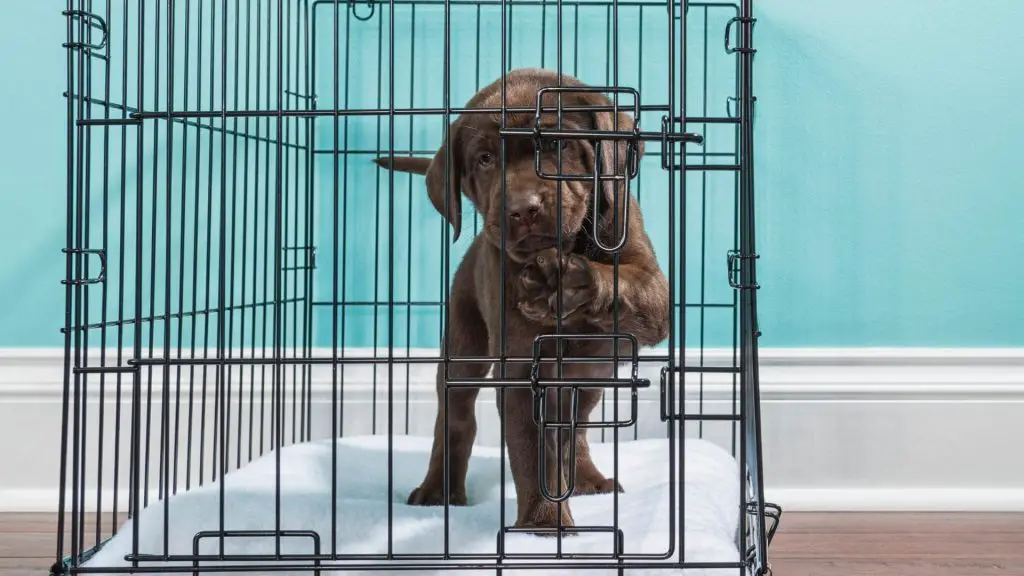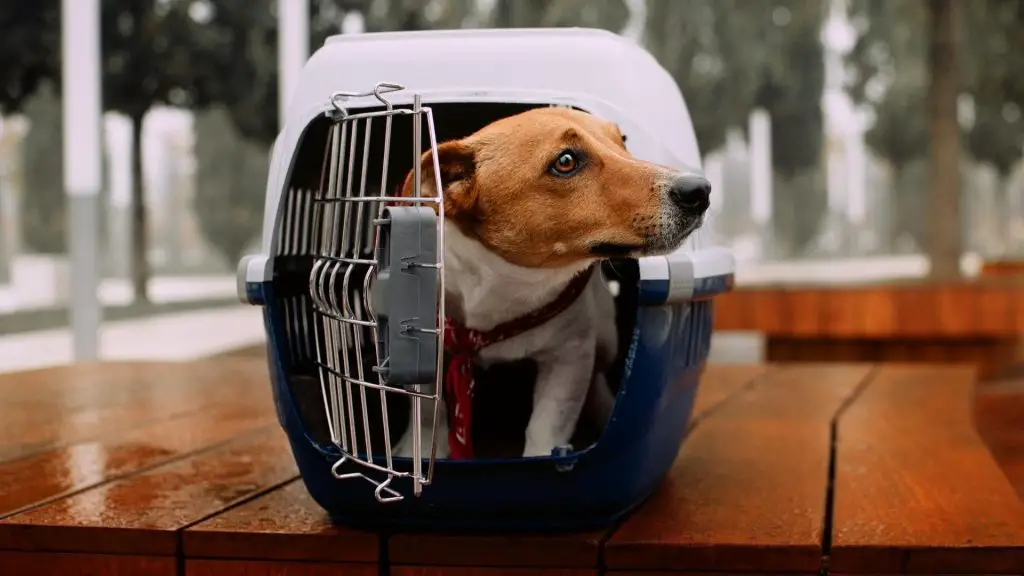Pawscessories is reader-supported. When you buy via links on our site, we may earn an affiliate commission at no cost to you.
Learn more.
Crating a dog can be quite a controversial topic. Many people feel strongly that crating a dog while at work is inhumane and if you take part in crating, you are considerably harming your dog.
But, is this entirely true? Can you crate a dog while at work and it be humane?
This article dives deep into when crating a dog is okay versus when it becomes harmful to your pup.
We also look at best practices when it comes to crating dogs while at work, how to determine the best crate, how long its okay to leave your dog crated, and more.
Continue reading so you can make sure your dog is not being negatively effected with being crated.
Table of Contents

Leaving A Dog In Their Crate While At Work: Cruel Or Not?
Leaving your dog in their crate while you’re at work can be a tough decision to make. After all, you don’t want to leave your furry friend alone for too long. But is it really cruel to do so?
Well, that depends on a few factors. The first is whether or not your dog has built a positive association with the crate. The second is how long you will be leaving them.
If your dog has a positive association with the crate, then leaving them for a few hours while you’re at work shouldn’t be a problem. However, if your dog is clearly anxious and stressed when in their crate, then it might be best to find another option or ensure they are only left for short periods.
In addition, regardless of whether or not your dog enjoys their crate, how long you leave them in their crate while you’re gone is what’s most important.
If you work 8 hours or more, a dog should not be left in their crate for this long. Leaving a dog confined to a small space for this long can lead to long term health issues. PETA believe dogs that are left in confined spaces can suffer from a list of psychological and physical problems.
So looking at the opinion from the organization People for the Ethical Treatment of Animals (PETA) leaving a dog in a crate while you are at work is considered cruel and unethical.
In addition, the ASPCA makes it clear that a dog crate should be used as a “short-term management tool”. They also make note of the positive effects a crate can have on dogs allowing them to have a safe space of their own.
Can I Crate My Dog While At Work?

So can you crate your dog while at work?
This depends on what country/state/city you live in as animal cruelty laws vary. For example, in the U.S. it is not illegal to crate your dog while at work. In the U.K. however, the Animal Welfare Act of 2006 makes it clear that dogs must have “the ability to exhibit their natural behaviour”.
In Finland its against the law to leave your dog in a crate. You may only do so for permissible reasons such as transportation or illness.
Aside from the laws where you live, crating a dog while at work is a personal decision. You will need to consider your dog’s individual needs, the length of time you’ll be gone, and the possible ramifications of leaving your dog in their crate while you are gone at work.
Is Crating Your Dog With Separation Anxiety While You Are At Work Okay?

If your dog has separation anxiety then it is not recommended to crate them while you’re at work or gone for extended periods of time. This is because the crate will likely exacerbate their anxiety.
However, crate training a dog with separation anxiety can be beneficial and some trainers encourage it. Crating an anxious dog may seem cruel, but it’s keeps them safe from hurting themselves or destroying your home while you’re away.
When crated, an anxious dog can’t pace back and forth, work themselves into a frenzy, or destroy your things. A dog crate also provides a feeling of security for an anxious dog. It’s their own little space where they can feel safe and relaxed. So crate training a dog with separation anxiety can be a good idea.
However, dogs with anxiety should not be left in a crate for long. If you must leave them for longer, consider hiring a dog sitter or taking them to a friends or doggy daycare.
How Long Can A Dog Spend In A Crate Before It’s Harmful?

If you have a dog that hasn’t been crate trained, it’s crucial to know how long your dog can be left in the crate.
Most dogs should only spend 8 hours at a time inside their crates and even less for older or younger puppies. In an Ideal situation you never want them left for more then 4 hours at a time.
It would be best not to leave your pup crated most of the day as this will make them feel abandoned rather than secure.
This goes against what they’re used for during training sessions.
They’re confined with treats and toys until released by an owner who gives praise after restricting them successfully on command.
Regardless, if it’s just 30 minutes or slightly longer, depending on individual circumstances, it’s okay. But always consider factors such as age, health, size, etc. before deciding upon anything concerning your pup.
Puppies should not be left for more then 1-2 hours as they may need to eliminate more frequently then an adult dog. Even so adult dogs should only be left for a maximum of 4 hours to avoid any negative health effects on your dog.
What Happens To Dogs Crated For Too Long?

If a dog is crated for too long, they may become anxious, depressed, or even start showing signs of aggression.
In addition, it can also cause dogs to develop anxiety or depression. This can lead to them pacing back and forth, barking, howling, whining, trying to escape from the crate, becoming withdrawn, losing interest in food and toys, and sleeping more.
Leaving a dog in a crate while at work for too long can also cause physical problems such as muscle atrophy, joint stiffness, and digestive issues.
So it’s important to not leave your dog in their crate for too long while you’re at work. If you must, consider hiring a dog sitter or taking them to a friend’s house or doggy daycare.
The Theory Behind Crate Training: Why Are Dog Crates So Popular?
Crate training is a method used to develop a dogs obedience and to help with things like potty training. They are also used to manage a dog’s behavior and provide them with their own safe space.
Crates have become increasingly popular among dog owners for several reasons:
- Dogs are den animals and crates mimic their natural environment.
- Crates provide a safe space for dogs when they are left home alone.
- Crates can prevent dogs from getting into trouble or damaging property when left unsupervised.
- Crates can be used to transport dogs safely in cars and airplanes.
- Crates can help with potty training and obedience training
Related Reading: The 27 Best Dog Crates For Small Dogs And Puppies
Crate Training A Dog While At Work

Crate training a dog while at work can be okay when done properly and without leaving them for too long. It can help with things like potty training, obedience training, and behavior management.
Here are a few tips for crate training a dog while at work:
One Size Does Not Fit All
Since dogs vary in size depending on their age and breed, here are sure signs that the crate you are using is too small for your furry friend:
They’re unable to sit upright
Your dog should be able to sit up straight inside the kennel with their head held high.
Your dog shouldn’t have to hunch or cramp in any way possible, ensuring they have enough room for comfort. If they don’t, the crate is too small.
They’re unable to turn comfortably
Your dog should also be able to turn around quickly in the crate. If they can’t, they’ll start developing health issues over time.
If your dog’s crate is too small, they may feel confined and uncomfortable. The only thing touching the cage should be their tail.
If your dog cannot stretch out
If a dog can’t lay down and stretch simultaneously, likely, there isn’t enough room in the crate.
You can measure your pup by having them lie down as they normally would before putting them inside of their kennel.
If the measurement is smaller than the length of the crate (with some wiggle room on both sides) then the size of the crate is just fine.
If your dog is uncomfortable
There are sure signs that your dog is uncomfortable, and they are:
- Growling
- Howling
- Barking
- Whining
- Shivering
- Pacing
If you notice these signs once you put your dog inside their crate, then they’re utterly uncomfortable, and the crate might be the issue.
Make It Comfortable
If you want your dog to stay in their crate while you’re at work without any issues, you should make sure that their crate is as comfortable as possible. This includes:
- Putting a soft mat or bed inside the crate
- Covering the crate with a blanket to make it dark (dogs can feel more secure in the dark)
- Adding some of their favorite toys or chews
- Putting a ticking clock inside the crate (mimics the sound of your heartbeat and makes them feel safe)
Familiarize The Crate

You should familiarize your dog with their crate before you leave them alone in it. This means letting them explore the crate on their own, without being forced inside. You can do this by:
- Putting the crate in a room where they spend a lot of time
- Leaving the door open so they can come and go as they please
- Putting their favorite toy or treat inside the crate
- Gradually increase the amount of time they spend in the crate
- Crating them for short periods of time while you’re home
Eventually, your dog will be comfortable enough to stay in their crate for longer periods of time.
Gradually Increase Time Away
Once your dog is comfortable in their crate, you can start leaving them alone for short periods of time. This means gradually increasing the amount of time you’re away from home. Start with 10-15 minutes and work your way up to an hour.
If your dog is prone to separation anxiety, it’s best to leave them in their crate while you’re home at first. This way, they’ll get used to being away from you without feeling anxious.
How To Know When To Stop
Stop the crate training process immediately if your dog shows signs of anxiety. This includes:
- Panting
- Excessive drooling
- Whining
- Barking
- Pacing
These are all signs that your dog is not ready to be left alone in their crate and needs more time to adjust. Crate training can be a great way to keep your dog safe and comfortable while you’re away from
Make It Their Home
The best way to make sure your dog is happy while you’re away is to make their crate their home. This means keeping the crate in a room where they spend a lot of time, such as the living room or bedroom. You should also keep their bed and favorite toys inside the crate so they feel comfortable and at home.
You can leave the TV on while you are away so they have something to watch and keep them company.
Once you have the foundations down you can start to leaving them while you go to work. Ideally you never want them left for more then 4 hours at a time.
Alternatives To Crating Your Dog While At Work
If you’re not comfortable with the idea of crating your dog while you’re away, there are some alternatives.
Dog Sitting
The first is to get a dog sitter. This is someone who comes to your house to check on your dog and let them out to pee. They can also provide them with food and water, and playtime.
Doggy Daycare
The second alternative is doggy daycare. This is a place where you can take your dog to stay during the day while you’re at work. They will be in a room with other dogs and have access to food, water, and playtime.
Hiring A Dog Walker
The third alternative is to hire a dog walker. This is someone who comes to your house to take your dog for a walk while you’re at work. They can also provide them with food, water, and a nice break from being in their crate.
Frequently Asked Questions
Is It Inhumane To Have A Dog Sleep In Their Crate At Night?
It’s not cruel at all! On the contrary: dogs love their crates because they’re cozy spaces that are just perfect for resting or chilling out after an exhausting day of fun with friends.
Dogs like to feel safe and secure, so crating your dog is a great way to make them feel comfortable at night.
For this reason, if you properly crate train your pup, they will be able to enjoy spending time in the crate.
It also helps prevent any unwanted behavior during precious sleeping hours.
Related Reading: What To Do If Your Dog Cries In The Crate | Simple Tricks
Why Do Some People Think Crating A Dog Is Inhumane?
Most people believe that crating is depriving your dog of their freedom of movement. Especially if you do it for too long.
PETA suggests that dogs crated for too long can suffer from psychological and physical problems.
These include bulimia nervosa, a major depressive disorder with atypical features. There are also obsessive-compulsive disorders like licking or chewing themselves excessively.
These are the results when you leave your dog isolated inside a crate for too long.
Is Crate Training A Dog Immoral?
Crate training isn’t immoral as long as you maintain a healthy time for your dog to stay locked.
It only becomes inhumane if your dog is trapped in a smaller cage and/or in unfavorable conditions for a more extended period.
For instance, placing the crate in the cold or the rain without covering your dog.
Morally, you must first provide a dog with a spacious crate to stretch, rest and turn. Then the crate must be well-ventilated and not a closed cage.
Thirdly, you must let your dog out for exercise and allow them to relieve themselves.
Also, make it a habit to use the crate only when restraining your dog when you’re at work, traveling with them, or when guests are over.
If you do it for punishment reasons or for excessively long hours (10-12 hours plus daily), then that is immoral crate training.
Can Crating My Dog Harm Them?
That depends on the situation. Crates are an essential tool that people use when training their dogs.
Crate training is a great tool to help your dog feel comfortable and safe when in an overwhelming environment.
It also prevents them from chewing up things around your home and helps with potty training. Crates have many other uses, too, such as safety while transporting your pup in your car.
It only becomes harmful when you crate your canine for too long. A crate isn’t always a magical solution to typical canine behavior. If you work for over 8 hours and your dog is left in their crate, this can cause long term damage to your dogs mental well being.
If you misuse a dog crate and they are left for too long it can be terrible for your dog. Overtime dogs will dread going in their crate and it will create a negative association that cause them anxiety and stress.
It can make them feel like they’re trapped and you may not return to get them. This can increase their stress and often leads dogs to develop bad habits.
Do Dogs Like Being Crated?
Again, this will depend on the circumstances of how you’re crating your canine. If you do it as a mode of punishment or for too long, then they might even refuse to enter.
But if you do it in a lighter, more friendly way, they’ll enjoy staying in the crate.
For example, suppose you have guests over, and you keep your pup inside the crate with an interactive toy to keep them busy; that is fine.
But if you only wait for them to misbehave, then put them in the crate, they associate it as a dungeon of punishment. Thus, they will grow to hate it.
You can train your dog to like their crate by rewarding them with treats when they enter the crate.
Put a treat inside the crate, and then let it stay open for some time.
Playing with your pup until they’re comfortable staying inside on their own without any rewards is the best way to do so.
Once you notice this has become routine behavior, close the door while still giving them one or two more snacks before letting them out of the crate again.
Final Thoughts
A crate can be a valuable tool for dog owners. Crates are often used to keep dogs safe, secure, and contained when they shouldn’t be roaming free.
They also provide an essential sense of security that helps calm some nervous or anxious doggos during storms or other scary events. However, when used wrong they can be cruel.
It’s not inhumane to crate your dog when you go to work if you are using it in the right way. If you leave your dog in their crate while you go to work for an 8-hour day, that is too long. You should only crate your dog while you are away for a few hours at most or if it’s absolutely necessary.
If you still feel you’d like more information, consult with your veterinarian about how best to care for your pet based on their specific needs and personality traits.
This is to make sure you’re doing what’s best for both of you!
Other posts you might find interesting:
Can My Dog Sleep With A Cone On? (Safety Tips + Risks)
